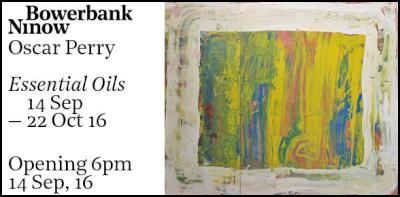Oscar Perry, Essential Oils, Opening Wednesday 14 September
Oscar Perry, Essential Oils, Opening Wednesday 14 September at 6pm

Oscar Perry’s new works offer a commentary on the political and cultural legacy of late modernism. According to the artist, “Instead of starting with figurative or landscape [subjects] and slowly building to the point of abstraction, I started with paranoid conspiracies and hundreds of hours of audio material. The paintings became misguided attempts at trying to document something that couldn’t be explained.”
The “paranoid conspiracies” which Perry refers to centre around the activities of the Congress for Cultural Freedom, an anti-communist advocacy group begun in 1950 which was instrumental in promoting American abstract expressionists such as Jackson Pollock throughout the West. In 1967, the CCF was revealed to have been a CIA front operation, designed to position American abstract painting as a counterpoint to the rigid realist principles of state-sponsored Soviet art, and thus create the impression that capitalist society was the natural home of the cultural avant-garde. This idea of art as a façade concealing a cynical, politically motivated ulterior purpose resonates with the uneasy surfaces of Perry’s work, and with the complexity and difficulty of producing paintings in the information-saturated contemporary landscape.
However,
the links between politics and painting are not the sole
driver behind this group of works. Perry compares the
activities of the CCF to the conspiracy theory which holds
that the Laurel Canyon music scene, which gave rise to the
Eagles, Jim Morrison and Frank Zappa, was in fact another
example of the CIA manufacturing culture, and that the hippy
counterculture was created by the CIA in order to sideline
and de-legitimise the anti-war movement. Perry links this
theory to the Dionysian Mysteries of ancient Greece, in
which participants in the religious rituals of the god
Dionysius dissolved their personal inhibitions through the
use of intoxicants and frenzied dancing. While this
secondary nexus of conspiracy and mythology is yet further
removed from the mainstream of history, it seems of a part
with Perry’s anxieties about the authenticity of culture
in general: In our present situation, how can we tell the
difference between art, propaganda and marketing? This
uncertainty is not limited to the viewer of art; Perry sees
the role of the painter as that of a “Manchurian
candidate,” driven by their cultural programming rather
than any intrinsic creative impulse.
Perry’s work
draws together disparate threads of conspiracy, history and
culture in his search for meaning, a hyperactive research
process facilitated by the instant accessibility and
infinite variety of the internet. “I basically looked at a
bunch of things and tried to connect them. I wanted to
create a studio environment where I could attempt to make
modern spiritualist paintings, like a theatre set for an
amateur performance.” As part of this neo-séance process,
Perry cites three historical figures in particular as
“spiritual guides/unreliable narrators” who influenced
the creation of the work: Admiral George Stephen Morrison,
the father of Jim Morrison; Vito Paulekas, a founding member
of the Southern California “freak” scene; and Sirhan
Sirhan, the man convicted of the assassination of Bobby
Kennedy. Each of these characters exemplifies a strand of
Perry’s research: George Morrison as the shadowy authority
figure standing behind the “authentic” manifestations of
the avant-garde, Paulekas as the Dionysian prophet whose
frenzied bacchanal dissolves the walls between self and
culture, and, standing in for the artist himself, Sirhan
Sirhan the erstwhile Manchurian candidate, whose journals
were discovered to contain strange scribbles and examples of
automatic writing.
The works in Essential Oils are likewise drawn from these three strands, as identified by Perry himself: “Honky Tonkin Gulf aerial paintings and porthole paintings, Laurel Canyon Dionysian dance paintings, and Sirhan Sirhan note book paintings.”
As Perry puts it: “Morrison as alter-ego. Vito as persona mask, Sirhan as guiding hand. Perry as Manchurian candidate.”
ends


 NZ Symphony Orchestra: NZSO To Tour Masterworks By Mozart, Beethoven, Haydn And More
NZ Symphony Orchestra: NZSO To Tour Masterworks By Mozart, Beethoven, Haydn And More Journal Of Public Health: Vape Shops Cluster Around Schools
Journal Of Public Health: Vape Shops Cluster Around Schools Timaru District Council: Aigantighe Art Gallery Hosts An Iconic Robin White Touring Exhibition
Timaru District Council: Aigantighe Art Gallery Hosts An Iconic Robin White Touring Exhibition Victoria University of Wellington: Dame Winnie Laban Awarded Honorary Doctorate Recognising Achievements For Pasifika
Victoria University of Wellington: Dame Winnie Laban Awarded Honorary Doctorate Recognising Achievements For Pasifika  HESSA: This Isn’t Fair—And It’s Time To Fix It - HESSA Petition Calls For Inclusive Student Sports
HESSA: This Isn’t Fair—And It’s Time To Fix It - HESSA Petition Calls For Inclusive Student Sports Post Primary Teachers' Association: PPTA Calls On Minister Stanford To Come Clean On Kāhui Ako
Post Primary Teachers' Association: PPTA Calls On Minister Stanford To Come Clean On Kāhui Ako 